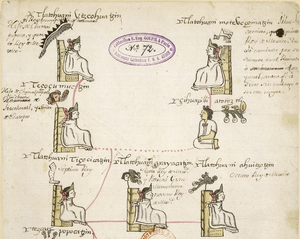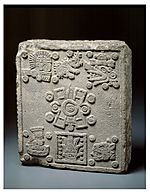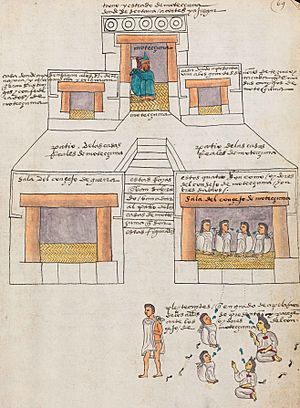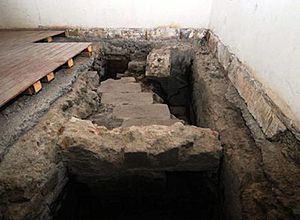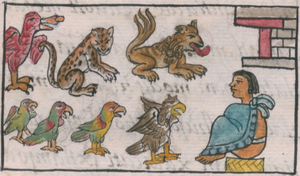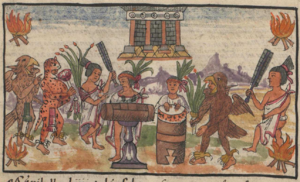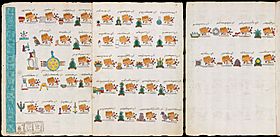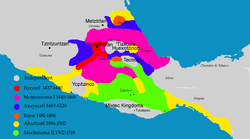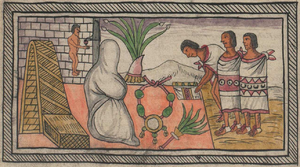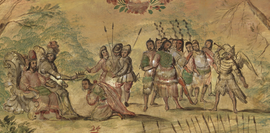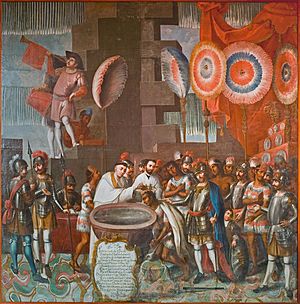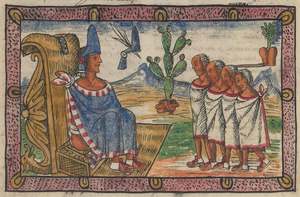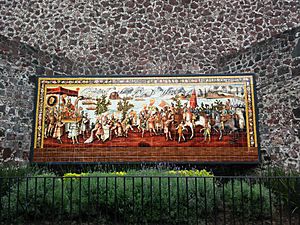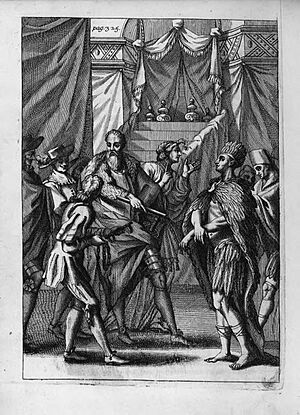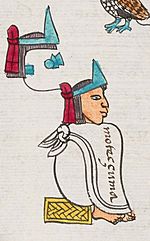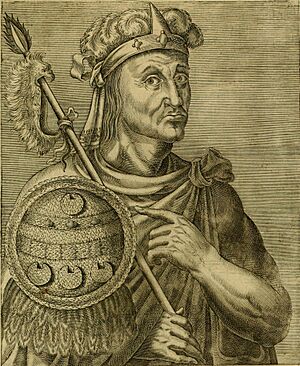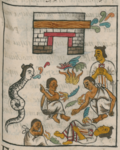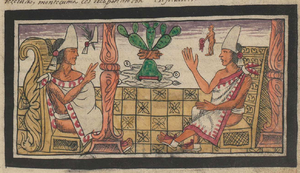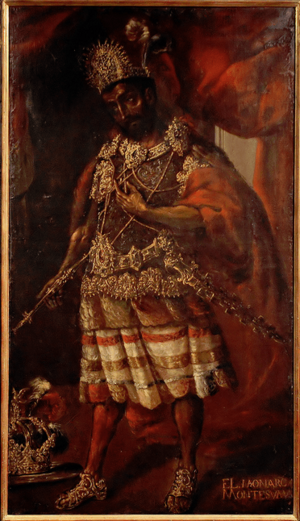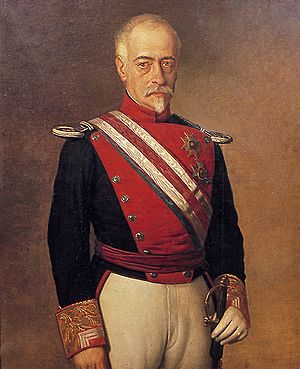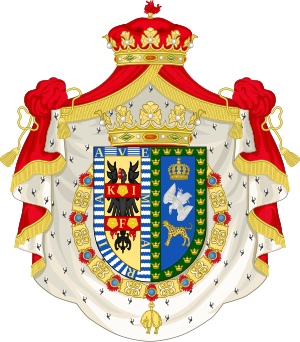Moctezuma II facts for kids
| Moctezuma Xocoyotzin | |
|---|---|
Quick facts for kids 
Late 17th-century portrait attributed to Antonio Rodríguez
|
|
| Huey Tlatoani of the Aztec Empire Tlatoani of Tenochtitlan |
|
| Reign | 1502/1503–1520 |
| Coronation | 1502/1503 |
| Predecessor | Ahuitzotl |
| Successor | Cuitláhuac |
| King consort of Ecatepec | |
| Tenure | 16th century–1520 |
| Born | c. 1466 |
| Died | June 30, 1520 (aged 53–54) Tenochtitlan, Mexico |
| Consort | Teotlalco Tlapalizquixochtzin |
| Issue Among others |
Isabel Moctezuma Pedro Moctezuma Mariana Leonor Moctezuma Chimalpopoca Tlaltecatzin |
| Father | Axayacatl |
| Mother | Xochicueyetl |
Moctezuma Xocoyotzin (born around 1466 – died June 29, 1520), also known as Moctezuma II, was the ninth emperor of the Aztec Empire. He ruled from 1502 or 1503 until 1520. He was also a king through his marriage to Queen Tlapalizquixochtzin of Ecatepec.
During his rule, the Aztec Empire became its largest. Moctezuma expanded the empire's land through battles. He also made changes to the social system, increasing the difference between nobles and common people.
Moctezuma's reign was when the Aztec people first met Europeans. He died during the early part of the Spanish conquest of the Aztec Empire. This was when conquistador Hernán Cortés and his soldiers tried to take over the Aztec capital, Tenochtitlan.
After Moctezuma's death, two more Aztec rulers took power, but their reigns were very short. The empire quickly fell apart. Many historical stories describe Moctezuma as weak or unsure. However, some people from his time saw him as a great leader who tried to keep his nation strong during a difficult period. Others thought he was a ruler who wanted too much power. His story is a well-known part of history about Europeans meeting Native Americans.
Contents
Understanding Moctezuma's Name
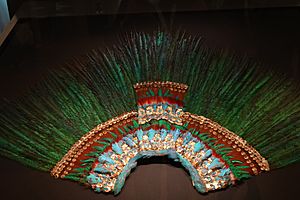
His name in the Nahuatl language means "he is one who frowns like a lord." It can also mean "he who is angry in a noble way." The Aztecs did not use numbers for their rulers. Historians later added "II" to his name to tell him apart from the first Moctezuma, Moctezuma I.
The Aztecs called him Motecuhzoma Xocoyotzin. Xocoyotzin means "honored young one." This helped distinguish him from Motecuhzoma Ilhuicamina, or "Old Moctezuma."
Moctezuma's Early Life and Rise to Power
Moctezuma II was the great-grandson of Moctezuma I. His father was Emperor Axayacatl. Like other Aztec nobles, Moctezuma was educated at the Calmecac. This was a special school for noble children. He started his education very young, around age five. He was known for being disciplined and religious.
Moctezuma was already a famous warrior before he became emperor. He held high ranks in the Mexica military. He was also a main priest of Huitzilopochtli's temple. His military and religious background helped him become the next ruler.
One important battle he fought in was the conquest of Ayotlan. This happened during the reign of the previous emperor, Ahuizotl. Moctezuma helped rescue Aztec merchants who were trapped by enemy forces. The people of Ayotlan surrendered soon after he arrived. Around 1490, Moctezuma earned the rank of tequihua. This rank was given to warriors who captured at least four enemy commanders.
Moctezuma's Coronation Ceremony
The exact year Moctezuma became emperor is not fully clear. Most historians believe it was 1502, but some say 1503. A stone called the Stone of the Five Suns has a date that matches July 15, 1503. Some think this was his coronation day. However, most old documents point to 1502.
Moctezuma's Reign as Emperor
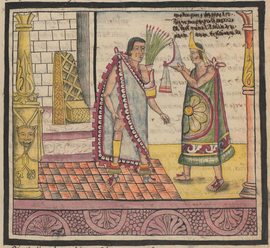
After becoming emperor, Moctezuma divided the empire into 38 new areas. This helped him make the empire more controlled by him. He sent officials and soldiers to these areas. Their job was to collect taxes, make sure laws were followed, and act as local judges.
Challenges and Changes During His Rule
Natural Disasters
Moctezuma's rule started with problems. In 1505, a big drought caused crops to fail. Many people in central Mexico began to starve. Moctezuma and other leaders tried to help. They used all available food and raised taxes for one year to get more supplies. The drought lasted three years. It became so bad that some nobles sold their children as slaves for food. Moctezuma ordered these children to be freed and food to be given to the nobles.
New Policies and Rules
Moctezuma made many changes to centralize power around himself. He replaced many of his advisors with people he preferred. He also increased the gap between nobles and common people. He stopped commoners from working in his palace or holding high government jobs. This was different from past emperors who allowed commoners in these roles.
Moctezuma wanted to make sure nobles did not threaten the government. He made nobles live permanently in Tenochtitlan. His economic policies were also affected by the droughts. Some areas had to pay more taxes to help feed the starving population. These new taxes sometimes made people unhappy. Some groups, like those in Totonacapan and Chalco, later joined Spain against him.
The famine also led to the end of the huehuetlatlacolli system. This was a system where families could become permanent serfs or slaves.
Building Projects
Moctezuma built a grand palace for himself. It was very large, even bigger than the modern National Palace in Mexico City. It was about 200 meters long and 200 meters wide. Not much of it remains today, but old descriptions tell us about it. Hernán Cortés himself said it was "so marvelous that it seems to me impossible to describe its excellence."
The palace had a large courtyard that opened to the city's main plaza. This courtyard was a place for many activities, including feasts. Around it were rooms and smaller courtyards with gardens.
His home had many rooms for different uses. There was a special room called Casa Denegrida (Black House). It had no windows and was painted black. Moctezuma used it for meditation. Parts of this room have been found in modern Mexico City. The palace also had rooms for government meetings and a war council.
One famous project was the Totocalli (House of Birds). This was a zoo with many kinds of animals, especially birds. It also had predatory animals like jaguars and snakes. Servants cared for the animals, feeding and cleaning them. Important people visited this zoo.
Sadly, the Totocalli was burned down in 1521 during the Siege of Tenochtitlan. Cortés ordered it burned to discourage the Aztec army.
Another project was the Chapultepec aqueduct, built in 1506. It brought fresh water from Chapultepec to Tenochtitlan. This water was for drinking and for the temples. The Spanish destroyed this aqueduct in 1521 to cut off Tenochtitlan's water supply during the siege.
Military Actions and Empire Expansion
At the start of his rule, Moctezuma tried to make peace with rival cities like Tlaxcala. He invited their leaders to his coronation, but secretly. He wanted to show them his power. However, these peaceful times did not last long, and big conflicts soon began.
Moctezuma's first military campaign was to stop a rebellion in Nopala and Icpatepec. Over 60,000 soldiers fought. About 5,100 prisoners were taken. Many were used as slaves or for human sacrifice. In Nopala, Aztec soldiers burned down temples and houses, even against Moctezuma's wishes. Many of Moctezuma's wars were about stopping rebellions, not just conquering new lands.
Rebellions and Challenges
Many rebellions happened during his reign. For example, after a defeat at Atlixco, many places in Oaxaca rebelled. They thought the empire was weak. But Moctezuma raised a huge army of 200,000 soldiers and put down these revolts.
In 1510, many rebellions broke out. Moctezuma spent years fighting them. Some revolts were far south, near today's Mexico-Guatemala border. These areas were important to the empire, so Moctezuma had to keep them under control.
Expanding the Empire
Moctezuma's empire mostly expanded into southwestern Mesoamerica. This included parts of Oaxaca and Guerrero. In 1504, the city of Achiotlan was conquered. Another conquest was Zozollan in 1506. This battle was very violent, with many prisoners sacrificed.
In 1507, a year of important religious ceremonies, many towns were conquered. These included Tecuhtepec and Tototepec. The conquest of Tototepec helped control the last Tlapanec lands in Guerrero.
Moctezuma also fought the Tarascan Empire. This was the first time since a big defeat under Emperor Axayacatl. This war caused many deaths on both sides. The Aztecs captured many enemies but did not conquer new land.
Before the Spanish arrived, Moctezuma led about 73 military actions. He won in about 43 places. This made him one of the most active rulers in Aztec history. However, the news of Spanish ships arriving in 1519 changed everything.
The Texcoco Succession Crisis
One major event during Moctezuma's rule was a problem with who would rule Texcoco. Texcoco was an important city allied with the Aztecs.
Nezahualpilli's Death
The ruler of Texcoco, Nezahualpilli, died suddenly in 1516. He did not name a successor. He had six sons, and several wanted to be the next ruler. Moctezuma supported his nephew, Cacamatzin. The Texcoco council agreed with Moctezuma, and Cacamatzin became the new ruler.
However, one of Nezahualpilli's sons, Ixtlilxochitl, disagreed. He thought Moctezuma supported Cacamatzin to control Texcoco. Ixtlilxochitl then started a rebellion. He gathered an army and took control of several cities around Texcoco. Moctezuma tried to help Cacamatzin and stop the fighting. Eventually, the brothers agreed to divide the region into three parts, with Cacamatzin still ruling Texcoco.
Spanish Involvement in the Crisis
This crisis became important again when the Spanish arrived. Cacamatzin tried to raise an army against the Spanish after they imprisoned Moctezuma. Cortés, the Spanish leader, told Moctezuma to have Cacamatzin arrested. Moctezuma suggested sending Ixtlilxochitl to do this. Cacamatzin was arrested, and Ixtlilxochitl became the new leader of Texcoco.
Ixtlilxochitl then fought with the Spanish. He became friends with Cortés and converted to Christianity. Some people see him as a traitor, while others see him as a brave warrior who fought against Moctezuma's rule.
Wars with Tlaxcala and Huejotzingo
The Aztec Empire had long-standing conflicts with Tlaxcala and Huejotzingo. These conflicts became much bigger during Moctezuma II's reign.
The Battle of Atlixco
| Battle of Atlixco | |||||||
|---|---|---|---|---|---|---|---|
| Part of the flower wars | |||||||
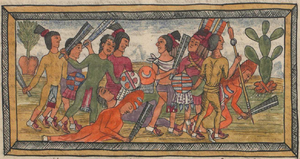 The defeat suffered at the battle of Atlixco against Huejotzingo, according to the Durán Codex |
|||||||
|
|||||||
| Belligerents | |||||||
| Huejotzingo | |||||||
| Supported by: Tlaxcala Cholula Tliliuhquitepec |
|||||||
| Commanders and leaders | |||||||
| Tlacahuepan † Moctezuma II |
Tecayahuatzin(?) | ||||||
| Strength | |||||||
| 100,000 warriors | Unknown (possibly 100,000 warriors) | ||||||
| Casualties and losses | |||||||
| Possibly over 20,000 killed. Many wounded. |
Possibly over 20,000 killed. Many captured. |
||||||
Around 1503 or 1507, a huge battle took place in Atlixco. It was mainly against Huejotzingo, a powerful kingdom. Moctezuma wanted this war because there had been no major battles for a while. This was a "flower war," a type of war fought for religious reasons, often to capture soldiers for sacrifice.
Moctezuma's brother, Tlacahuepan, led 100,000 Aztec troops. The battle was fierce. Tlacahuepan was surrounded and killed on the battlefield. The Aztec troops then retreated. This defeat was very embarrassing for the empire. About 20,000 people died on each side. Moctezuma was very sad about the loss.
Even though Huejotzingo won, they also lost many soldiers. This battle weakened them greatly. In the following years, they lost more battles to Tlaxcala and Mexico. This eventually led to their downfall.
Invasion of Tlaxcala
Around 1504 or 1505, major conflicts began between Mexico and Tlaxcala. Moctezuma thought about surrounding Tlaxcala, as most of it was bordered by Aztec lands. However, many of his own allied towns did not want to fight Tlaxcala.
Tlaxcala launched a counter-attack against Huejotzingo, knowing they were weak. Huejotzingo asked Moctezuma for help. Moctezuma agreed and sent many soldiers to help them. The fighting continued for many years, with huge losses on both sides.
By 1516, Huejotzingo left its alliance with the Aztec Empire. The wars had made Huejotzingo weak enough for Tlaxcala to conquer it. Tlaxcala then became the most powerful rival to the Aztec Empire in central Mexico. This war had terrible results. The Tlaxcalans later allied with Spain against the Aztecs in 1519. They wanted to destroy Moctezuma's rule.
Meeting the Spanish Explorers
First Encounters
In 1518, Moctezuma heard reports of Europeans landing on the east coast of his empire. This was the expedition of Juan de Grijalva. Moctezuma ordered extra guards to watch the coast.
When Hernán Cortés arrived in 1519, Moctezuma was told right away. He sent messengers to meet the newcomers. As the Spanish got closer to Tenochtitlan, they made an alliance with the Tlaxcalteca. The Tlaxcalteca were enemies of the Aztecs. They helped the Spanish cause revolts in Aztec towns. Moctezuma knew this and sent gifts to the Spanish. He probably wanted to show them his power.
On November 8, 1519, Moctezuma met Cortés on the causeway leading into Tenochtitlan. They exchanged gifts. Moctezuma gave Cortés an Aztec calendar made of gold and silver. Cortés later melted these down for their value.
Cortés claimed that Moctezuma immediately offered his entire empire to the King of Spain. Some Aztec stories from the 1550s partly support this. However, it is hard to know what Moctezuma truly said. Aztec rulers used very polite language that needed careful translation. Some historians think Moctezuma's words might have been a polite way to show his own power, which was common in Aztec culture.
Moctezuma Becomes a Prisoner
Six days after the Spanish arrived, Moctezuma became a prisoner in his own palace. The exact reason is not fully clear.
The Spanish said it was because an Aztec tax collector named Qualpopoca attacked a Spanish group. This attack killed some Spanish soldiers. Some historians believe Cortés used this as an excuse to imprison Moctezuma and take control of Mexico. Cortés himself said he imprisoned Moctezuma to keep control over the empire.
Moctezuma said he was innocent of the attack. Qualpopoca was captured and executed, but Moctezuma remained a prisoner. Even as a prisoner, Moctezuma lived somewhat comfortably. He was still treated with respect as a monarch. However, he had lost most of his power. The Spanish watched almost everything he did.
Moctezuma often protected the Spanish from threats. He did this either because the Spanish forced him or because he wanted to. For example, he ordered the arrest of Cacamatzin, who was planning to attack the Spanish.
The Aztec nobles became very unhappy with the large Spanish army staying in Tenochtitlan. Moctezuma told Cortés it would be best if they left. In April 1520, Cortés left to fight another Spanish group. While he was gone, fighting broke out between the Spanish and Aztecs. This was the Massacre in the Great Temple. Moctezuma became a hostage used by the Spanish to protect themselves.
Moctezuma's Death
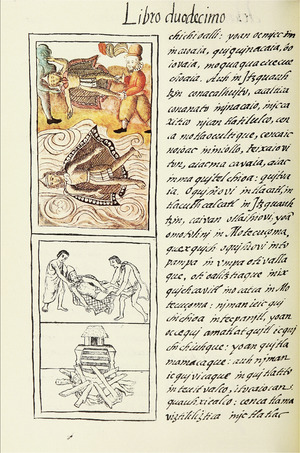
Moctezuma was killed during the battles with the Spanish after Cortés returned. The exact details of his death are not fully known, as different sources tell different stories.
One account, by Bernal Díaz del Castillo, says that on June 29, 1520, the Spanish forced Moctezuma to appear on his palace balcony. He was asked to tell his people to stop fighting. Díaz says that Aztec leaders spoke with Moctezuma. They asked their people to stop firing weapons. However, the Aztecs were angry with their leader. They had chosen his brother Cuitláhuac as the new emperor. Díaz says Moctezuma was hit by three stones and died.
Another account, from the Florentine Codex, says that the Spanish killed Moctezuma. This codex was written by native people after the conquest.
What Happened Next
After Moctezuma's death, the Spanish were forced to leave Tenochtitlan. They went to Tlaxcala and made a deal with the Tlaxcalans to conquer Tenochtitlan. They promised Tlaxcala control of the city and freedom from taxes.
Moctezuma was followed by his brother Cuitláhuac. Cuitláhuac died soon after from a smallpox disease. His young nephew, Cuauhtémoc, became the next ruler. During the siege of Tenochtitlan, Moctezuma's sons were killed by the Aztecs. This might have been because they wanted to surrender. Within a year, the Aztec Empire fell to the Spanish and their Native American allies, especially the Tlaxcalans.
Historical Views of Moctezuma
Many historical accounts describe Moctezuma.
Bernal Díaz del Castillo's Account
Bernal Díaz del Castillo was a Spanish soldier who was with Cortés. His book, True History of the Conquest of New Spain, describes Moctezuma as a noble leader. He tried to keep his kingdom in order even after being taken prisoner.
Díaz wrote that when Moctezuma died, Cortés and all the soldiers cried for him. They mourned him "as if he were our father." Díaz said Moctezuma had ruled for seventeen years and was "the best king they ever had in Mexico."
Hernán Cortés's Letters
Hernán Cortés wrote letters to the King of Spain to explain his actions. He described Moctezuma as believing the Spanish were gods. He also wrote that Moctezuma offered his empire to the Spanish king. Some historians believe Cortés might have written this to make his actions seem more justified to the Spanish Crown.
Bernardino de Sahagún's View
The Florentine Codex was created by Bernardino de Sahagún with help from native Aztec informants. This work often shows Moctezuma as a weak, superstitious, and self-indulgent ruler. Some historians think the Aztecs might have made Moctezuma a scapegoat for their defeat.
Indigenous Stories of Omens
The Florentine Codex also lists eight events that happened before the Spanish arrived. These were seen as signs of disaster, like a comet or a temple burning. Some believe the Aztecs were very worried about these signs. This was because the Spanish arrived during a "tying of years" ceremony. This ceremony marked the end of a 52-year cycle in the Aztec calendar. Aztecs believed this time brought changes and dangerous events.
Historian Diego Durán wrote that Nezahualpilli warned Moctezuma about the empire's destruction by a foreign invader. This warning made Moctezuma very fearful. These stories might have been created after the conquest to explain why the Aztecs lost. They also show Moctezuma as indecisive and superstitious.
Moctezuma's Personal Life
Moctezuma had many wives and children. Only two women were considered queens: Tlapalizquixochtzin and Teotlalco. His marriage to Tlapalizquixochtzin also made him king of Ecatepec.
The exact number of his children is not known. One Spanish writer claimed he had 100 children and 50 pregnant wives when he was captured. This might be an exaggeration. Some of his notable children were Princess Isabel Moctezuma and Prince Pedro Moctezuma.
Daily Activities and Hobbies
Moctezuma enjoyed sports like archery and swimming. He was also a skilled warrior from a young age.
He was an active hunter. He often hunted deer, rabbits, and birds in a special forest, likely the Bosque de Chapultepec. This forest was only for him and his guests. Anyone entering without permission could be put to death.
Moctezuma was very focused on cleanliness and personal hygiene. He bathed multiple times a day in his private pool. He also wore different clothes every day.
Moctezuma's Legacy
Descendants and Nobility
Moctezuma II has many descendants in Mexico and Spain. These include the families of his son, Pedro Moctezuma, and his daughter, Isabel Moctezuma. Isabel Moctezuma was given a large estate by Cortés. She had children who became part of important families.
Moctezuma's grandson, Diego Luis de Moctezuma, was taken to Spain by King Philip II. In 1627, Diego's son was given the title Count of Moctezuma. This made him part of the Spanish nobility. Later, this title became Duke of Moctezuma.
Indigenous Stories and Symbolism
Many native peoples in Mexico still worship gods named after Moctezuma. They often believe that the deified Moctezuma will return to help his people. His name appears in rituals of the Pame, Otomi, Tepehuán, Totonac, and Nahua peoples.
Moctezuma's name has also been used in several native rebellions as a symbol of resistance against the Spanish. For example, in a rebellion in Chiapas in 1721, followers believed Moctezuma would return to help them. In a Maya rebellion in 1761, the leader Jacinto Canek called himself "Little Montezuma."
See also
 In Spanish: Moctezuma Xocoyotzin para niños
In Spanish: Moctezuma Xocoyotzin para niños
- Historic recurrence
- Moctezuma I
- Moctezuma's Table
- Montezuma's headdress
- Qualpopoca
- Emperor



